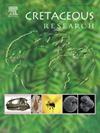New rebbachisaurid (Dinosauria, Sauropoda) from the Huincul Formation (upper Cenomanian-Turonian) of Villa El Chocón (Neuquén Province, Argentina)
IF 1.7
3区 地球科学
Q1 GEOLOGY
引用次数: 0
Abstract
Cienciargentina sanchezi gen. et sp. nov. is a new rebbachisaurid sauropod dinosaur from the Late Cretaceous of Argentina. The new species is erected on the basis of a unique combination of characters that includes many autapomorphies, among them: cervical epipophyses absent, anterior dorsal centra amphicoelous to slightly opisthocoelous, posterior dorsal centrum slightly opisthocoelous, posterior dorsal neural spines anteroposteriorly extended, mid and posterior dorsal vertebrae with intrapostzygapophyseal lamina supporting the postzygapophyses from below, middle and posterior dorsal vertebrae with accesory spinodiapophyseal lamina, lateral laminae in anterior caudal vertebrae formed by the spinoprezygapophyseal lamina and the spinopostzygapophyseal lamina, which fuse at the middle of the neural spine, anterior caudal vertebrae with spinoprezygapophyseal lamina more robust than spinopostzygapophyseal lamina, anterior caudal transverse processes with a full suite of diapophyseal laminae (anterior centrodiapophyseal lamina, posterior centrodiapophyseal lamina, prezygodiapophyseal lamina, postzygodiapophyseal lamina), ratio of length to height of the posterior caudal vertebrae 5 or higher, forked chevrons without anterior and posterior projections, and femoral head dorsally directed, rising well above the level of the greater trochanter. This new species is added to the list of rebbachisaurid sauropods documented in the Huincul Formation (upper Cenomanian-Turonian), which are thought to be the latest diplodocoids at global level. In fact: from the Turonian onwards, sauropod communities are composed exclusively of macronarians, mostly titanosaurs. In Patagonia, particularly in the Huincul Formation, the hypothetical faunal turnover that occurred in the middle of the Cretaceous, which involved not only sauropods but other groups of dinosaurs, is observed, perhaps like nowhere else in South America.
阿根廷Villa El Chocón (neuqusamn省)Huincul组(上Cenomanian-Turonian)新rebbachisaurid(恐龙属,蜥脚类)
Cienciargentina sanchezi gen. et sp. 11 .是发现于阿根廷晚白垩纪的一种新发现的rebbachisaurid蜥脚类恐龙。这个新物种是在包括许多自异形的特征的独特组合的基础上建立起来的,其中包括:颈椎附着物缺失,前背中央有两窝到轻微的凹穴,后背中央有轻微的凹穴,后背神经棘向前伸展,中、后背椎骨有椎突内板从下面支撑着后椎突,中、后背椎骨有辅助椎突板,尾椎前侧侧椎板由棘突椎板和棘突椎板组成,它们在神经脊柱的中间融合,尾椎前侧椎板与棘突椎板比棘突椎板更坚固,尾椎前横突具有一整套棘突椎板(棘突前中央椎板、棘突后中央椎板、棘突前椎板、棘突后椎板),后尾椎骨长度与高度之比为5或更高,分叉状,无前后突出,股骨头背向,远高于大转子的水平。这一新物种被添加到Huincul组(上cenomian - turonian)记录的rebbachisaurid蜥脚类恐龙名单中,该名单被认为是全球范围内最新的梁龙科动物。事实上:从Turonian开始,蜥脚类动物群落完全由巨龙组成,主要是泰坦龙。在巴塔哥尼亚,特别是在Huincul组,人们观察到白垩纪中期发生的假想的动物更替,不仅涉及蜥脚类恐龙,还涉及其他恐龙群,这可能是南美洲其他地方所没有的。
本文章由计算机程序翻译,如有差异,请以英文原文为准。
求助全文
约1分钟内获得全文
求助全文
来源期刊

Cretaceous Research
地学-地质学
CiteScore
4.10
自引率
19.00%
发文量
235
审稿时长
12 weeks
期刊介绍:
Cretaceous Research provides a forum for the rapid publication of research on all aspects of the Cretaceous Period, including its boundaries with the Jurassic and Palaeogene. Authoritative papers reporting detailed investigations of Cretaceous stratigraphy and palaeontology, studies of regional geology, and reviews of recently published books are complemented by short communications of significant new findings.
Papers submitted to Cretaceous Research should place the research in a broad context, with emphasis placed towards our better understanding of the Cretaceous, that are therefore of interest to the diverse, international readership of the journal. Full length papers that focus solely on a local theme or area will not be accepted for publication; authors of short communications are encouraged to discuss how their findings are of relevance to the Cretaceous on a broad scale.
Research Areas include:
• Regional geology
• Stratigraphy and palaeontology
• Palaeobiology
• Palaeobiogeography
• Palaeoceanography
• Palaeoclimatology
• Evolutionary Palaeoecology
• Geochronology
• Global events.
 求助内容:
求助内容: 应助结果提醒方式:
应助结果提醒方式:


